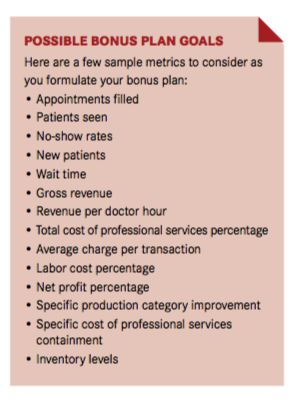Implementing a Bonus Program
When designed right, incentive plans can engage and motivate your team, help achieve practice goals, and increase efficiency and profitability.

A few years ago, I was asked to help a practice evaluate and improve on a generous bonus program focused solely on increasing revenue. If the gross revenue generated in the month was 10 percent more than the revenue generated in the same month of the prior year, the whole team would share a bonus. The practice team hit the mark several months during the year, was paid thousands of dollars in bonuses and grew the top line tremendously.
The problem, however, was that the clinic’s net profit was spiraling downward. During our evaluation of the program, we discovered that to service this tremendous growth, efficiency was suffering throughout the practice.
Besides bonuses, substantial overtime wages were being paid because the clinic was so busy that no one could hire or schedule. Clinic supply costs also increased, including excess waste because of timing issues with appointments and surgery schedules. In addition, inventory that the practice didn’t need was languishing on the shelves, including a large number of expired medications, because no one had time to manage the hospital’s inventory properly. Ultimately, although the practice got what it paid for — an incredible growth in gross revenue — it wasn’t worth the cost!
RELATED:
- Today's Best Credit Card Rewards Programs
- Work Perks Your Team Will Love
It’s been proved that well-planned bonus programs will give your team incentive, show how much you value them and ultimately increase your clinic’s performance. So where do you start?
Can You Afford It?
First, determine whether an incentive program makes sense for your practice. Can you afford it? To answer this question, analyze various clinic metrics, including a detailed review of your financial statements and key performance indicators. Compare your historical data with your current period data, and look for any trends that have developed. Ideally, you should evaluate your financial information and metrics for the past 24 months.
As you perform the analysis, the most important question to ask is whether your practice is profitable. According to Denise Tumblin, CPA, owner and president of WTA Veterinary Consultants in Columbus, Ohio, “A well-managed practice averages a profit to gross revenue ratio of 33 percent to 42 percent.” This ratio is determined without including owner and associate compensation.
The American Animal Hospital Association’s “Financial and Productivity Pulsepoints” indicates that the average profit to gross revenue ratio (prior to owner compensation) is 34 percent.1 If your clinic’s ratio is 28 percent or higher, you may have the profit to support a monetary bonus program, and if you are at or near that percentage, you also have room for improvement. If your ratio is below 28 percent, consider starting with nonmonetary rewards.
Do You Have Cash Available?
The next question is whether there is cash avail-able to pay the bonus. Your practice may show a healthy profit, yet because of debt payments, owner distributions or other nonexpense cash items, it could be cash-poor. To ensure you have the cash on hand to pay the bonus, prepare a cash-flow forecast. Begin with your current cash on hand, predict and add your revenue, and then predict and deduct your expenses for the period to arrive at your ending cash on hand. Ask your practice manager or accountant for help if needed.
During your financial statement and metric review, look for areas ripe for improvement. Building an effective incentive plan includes forming the right measures and metrics, making them measurable and concentrating on those that will affect your bottom line dramatically. When formulating the goals, remember to concentrate on areas that will improve performance, create focus, encourage a culture of ownership and positively influence behaviors.
Seek Team Input
Solicit input from your practice manager, team leaders and employees. Because they are in the trenches, they know where there’s room for improvement, and they likely will have thoughts and ideas about what goals will increase efficiency and add profitability. Ask your colleagues what has worked for them. Read journals and research incentive plans.
After reviewing your metrics, doing your research and talking with colleagues and friends, develop your own unique bonus plan based on what you want to achieve (see Possible Bonus Plan Goals).

There is no end to what can be measured, but it’s best to keep your plan simple and relevant. Choose what’s important to you and what will accomplish your practice goals. For the plan to succeed, educate your team so they understand the goals, the process for tracking and the reward. Communicate with them regularly to keep these initiatives top of mind and to gain a true sense of how the team is progressing.
It’s a reality that we all can’t be Google, where employees have free food available at 16 gourmet cafes, on-site gyms and medical care, or Netflix, where employees receive unlimited vacation. However, once you’ve established your metrics and goals, there are many creative ways to reward your employees. A monetary incentive is any compensation that increases an employee’s earnings based on accomplishing the established goals. Although there are various ways to calculate rewards, a bonus pool shared by team members typically works well in veterinary practices and encourages teamwork. You can split the bonus pool evenly among team members, allocate it based on hours worked or use any other reasonable method. This incentive strategy is often called profit-sharing.
Consider Nonmonetary Incentives
Multiple studies have shown that employees value compensation, but they value recognition, job fulfillment, communication and transparency just as much, if not more. This is good news for practices that don’t have the cash necessary or aren’t ready to jump into a monetary bonus program. Nonmonetary incentives can take many forms, and they don’t necessarily have to cost a lot of money. Consider such nonmonetary incentives as:
- Catered lunch at the clinic; invite spouses and significant others for an even bigger celebration
- Time off for each employee (within reason and appropriately scheduled)
- Team social events, such as a picnics, movie nights or sports events
- Team photo for a “Wall of Fame” area in the waiting room; take individual photos and give to employees
- Gift cards to gas stations, grocery stores, restaurants, movies or specialty stores
- Mobile car wash at the practice
- Chair massages at the clinic
If you’re struggling for ideas, ask your team. They will likely choose something reasonable, resulting in a win-win for everyone; you will achieve your practice goals, and your team will get what they asked for.
Ms. Bailey is founder and president of Camala C. Bailey, CPA, PC — CPA 4 Vets. Her financial services firm focuses exclusively on serving veterinarians, helping them to start, buy, grow and sell their practices. She also enjoys speaking at conferences, where she educates her audience on finances including profitability, practice value, taxes and operations. You can reach her at Cammi@CPA4Vets.com or 800-359-8175.
Reference:
- American Animal Hospital Association. Financial and Productivity Pulsepoints. 9th ed. Lakewood, CO: AAHA Press; 2017.











